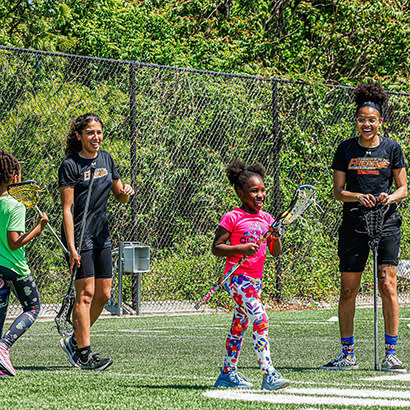
For an enhanced digital experience, read this story in the ezine.
While more women than ever are finding themselves in spaces that were previously held by men, it is important to note that sports participation is still dominated by males. At the District of Columbia Department of Parks and Recreation (DPR), we knew that to grow girls’ sports opportunities, we had to make connections that would drive participation.
Growing Girls’ Sports
First, we encouraged girls already participating in DPR programs to explore new sports by hosting clinics where they could sample different sports. To expand our reach even further, we asked those participants to bring a friend.
We dedicated staff and resources to this initiative to ensure it would flourish. Also, we brought in partners who were looking to build outreach, such as high school coaches and adult teams, who could lead the clinics, creating a win-win-win for DPR, the partners and the girls themselves.
Just one of our success stories is that of Naima Moore, who joined the gymnastics program, which led to more sports, like dance, basketball and volleyball. Through each of these activities, Moore’s confidence grew. Her teacher noticed her encouraging classmates to “never give up.” Without knowing it, Moore became an ambassador for DPR, sharing with peers her successes, and most of all, the fun.
Moore’s story resonates with the broader goals of DPR’s initiative, emphasizing the transformative power of sports in shaping young lives and connecting with others.
Expanding Offerings
Beginning in February 2023, DPR hosted the clinics not only to build interest, but also to identify sports with untapped potential. Prior to this initiative, DPR only offered three sports for girls — basketball, cheerleading and soccer. Through this work, four additional sports have been added: gymnastics, volleyball, lacrosse and flag football.
Two standout successes were the volleyball and flag football clinics, each attracting more than 150 participants. These events not only showcased the demand for these new sports, but also highlighted the strategic planning behind DPR’s efforts. By investing in dedicated staff, including hiring of K’Yanna Blackwell, DPR’s first girls and women sports manager, and fostering a sense of community through these clinics, DPR broke down barriers that may have hindered girls from exploring and excelling in sports.
Investing in Girls’ Sports
DPR backed its commitment to girls’ sports with tangible investments. An underutilized recreation center was transformed into a state-of-the-art gymnastics facility, meeting the demand generated by the popularity of girls’ gymnastics programs. Putting dollars behind infrastructure provides a clear message — that girls’ sports are not an afterthought, but a priority.
One of the most notable outcomes of DPR’s initiative was the significant increase in lacrosse participation. Addressing unmet demand, DPR adapted dynamically, doubling the participation rate from fall to spring. This surge in interest not only emphasizes the success of the initiative, but also underscores the importance of listening and responding to the needs of the community.
By creating partnerships, allocating resources and expanding offerings for girls’ sports, DPR has set a powerful blueprint. The overwhelming response to the clinics, expanded sports offerings and acceptance of new sports by our target audience highlight the transformative impact of focusing on our girls creating a legacy that extends beyond the playing fields.
Thennie M. Freeman is Director of District of Columbia Department of Parks and Recreation.

